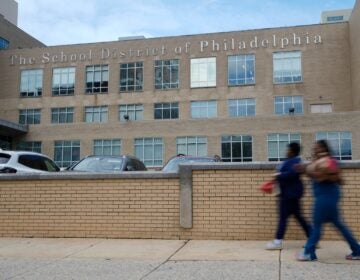Building a workforce for PHLPreK: Not an easy proposition
The salary and prestige of these jobs are still low, despite their importance to child development.

Mayor Jim Kenney visits with children at Little Learners Literacy Academy in South Philadelphia. (Emma Lee/WHYY)
The decision by Mayor Jim Kenney to focus on expanding public pre-K options with a locally funded program certainly had its controversies. Most obviously the decision to fund it with a sugary-drinks tax has come under relentless legal challenges from the soda industry. But everyone involved in the early childhood education community, from the Mayor’s office and the School District of Philadelphia to the smaller participating community providers, seems to agree that the program, known as PHLPreK, has already improved quality and availability around the city, particularly for low-income parents.
Yet they also seem to agree on the program’s most fundamental problem: staffing.
“Oddly enough, of all the work and all the challenges we face, the hardest thing we do is finding highly qualified, dedicated staff,” said Leslie Spina, director of Kinder Academy, a pre-K provider that includes five locations in Northeast Philadelphia serving 500 students, including a handful of PHLpreK classrooms.
In West Philadelphia, Pamela Alexander said the same thing. Alexander is the owner and director of Exceptional Learning Academy, a PHLpreK center that enrolls just under 30 students at its single Philadelphia location. “I have had a tough time with staffing, I’m not going to kid you,” said Alexander, citing high turnover as her main challenge.
With PHLpreK looking to ramp up expansion after a more modest launch due to the prolonged soda-tax litigation, the problem remains that there are simply not enough credentialed teachers to fill the classrooms.
As a result, workforce development has become a primary concern. But for some, it is also viewed as an opportunity.
Harnessing the existing network
Long before PHLpreK, there existed a variety of publicly-funded childcare options in the city, most of it provided by the School District as a contractor for federal (Head Start) and state (Pre-K Counts) programs. Others were and still are privately run and funded, some in community centers and rented spaces, others in people’s homes.
Historically, providers who did not receive public funds were less stringently regulated, although they could opt into the Keystone Stars quality metrics established by the state. If a center was strictly private and didn’t receive funding from one of the public programs, it wasn’t required to have fully credentialed teachers — those with an associate’s or bachelor’s degree or an early childhood certificate. Even so, many of these centers provided highly-valued services in their communities and those who had worked in them had been teaching for decades.
In creating the PHLpreK program, universal pre-K advocates wanted to find a way to harness this existing network, but also ensure the kind of quality necessary for the long-term impacts of pre-K to take hold.
“There was no reason to put [the private centers] out of business,” said Diane Castelbuono, the deputy chief of Early Learning for the School District. The Philadelphia Commission on Universal Pre-Kindergarten, which published a report of recommendations that guided policy as the Mayor’s Office of Education launched PHLpreK, stressed the need to incorporate the existing workforce and robust pre-K landscape into the long-term plan.
Even before PHLpreK, the city educators were convinced by the data showing that expanded high-quality publicly funded pre-K programs increase kindergarten readiness.
But this only happens when the system of centers is armed with a skilled, well-trained staff, something that is not at all simple. While providers that operate only with private dollars have had fewer regulatory requirements, even publicly-funded centers have faced varied credential requirements depending on the funding source. One of the goals of PHLpreK is to bring up the overall quality of Pre-K in Philadelphia, not just the quality of their funded spots.
For instance, lead teachers in a PHLpreK-funded classroom must have an associate’s degree and an Early Childhood Education certification. But lead teachers in a Pre-K Counts-funded classroom must have bachelor’s degrees.
“As opposed to thinking about our office’s role as just PHLpreK and that’s it, what we’re also striving to do is shift the landscape, and build a pipeline of quality,” said Sarah Peterson, the spokesperson for the Mayor’s Office of Education. “We see ourselves as affecting the early childhood education sector on the whole.”
Yet the average salaries earned by pre-K teachers, estimated by the Philadelphia Commission on Universal pre-K Recommendations Report published just before the launch of PHLpreK, was $16,000 for an aide, $20,000 for an assistant teacher and $27,000 for a lead teacher with a teaching certification. This makes it incredibly difficult for pre-K teachers to invest in further educational development, even if it means better compensation both for the teacher and for the pre-K center, depending on which program is funding that particular classroom.
So the issue is twofold: how to transition an existing workforce that is experienced but not credentialed, and how to build a pipeline to create more pre-K teachers?
Building a new pipeline
An apprenticeship program launched through the 1199C Training and Upgrading fund aims to tackle the issue of early childhood workforce development from both sides. Started around the same time as PHLpreK, this initiative updates an older model of manufacturing apprenticeship programs.
The partnership among 1199C and the community colleges in Philadelphia and Montgomery County designates teachers already employed in pre-K classrooms as apprentices and pairs them with mentors and classes to earn their associate’s degrees. The program mandates that the apprentice attend classes at the college in current best practices while counting students’ current employment as on-the-job training. And the apprentices are given credits for prior learning such as the earning of a Child Development Associate Credential or CDA.
The ability to both train an existing workforce and recognize existing qualifications is a “game changer,” according to Cheryl Feldman, the director of the District 1199C Training & Upgrading Fund. A coach or mentor meets with the apprentice weekly and connects the classroom instruction with their on-the-job experience teaching pre-k, assessing the attainment of the relevant competencies.
“This makes for a more impactful learning experience, but also an accelerated path to a degree,” explained Feldman. Apprentices must work while they gain their credentials and pay 5 percent of the tuition. They get tuition support for 90 percent of the total price from the TEACH scholarship, given out by the state, and an additional 5 percent from the apprentice’s employer. The ability to work as well as get tuition support allows teachers interested in gaining their credentials to do so. Without it, the cost would be untenable given the average salary for pre-K teachers. Mentors are also compensated by 1199C.
The first class of 36 apprentices started in 2017 and the next class of the same size will start later this year. Five students from the first class have already graduated, with three who chose to continue on to get a bachelor’s degree and a teaching certificate through a partnership between the Community College of Philadelphia and Arcadia University.
Additionally, 1199C is looking to work with an existing Early Childhood education CTE program at Parkway West High School that allows students to earn their CDA while still in high school, hoping to create a direct pathway from there to the apprenticeship. This lays out a clear path from high school through higher education to a sustainable job without the prohibitive costs and provides the ability to earn a living along the way. This type of model, Feldman hopes, would combat the early childhood education teacher shortage in a way that is sustainable for both teachers and the city.
If expanded (and 1199C has already received funds to spread the program statewide), this model could address both issues with the development of a sustainable early childhood education workforce — building the pipeline and making it financially feasible for experienced workers to earn the right credentials.
However, there is a fundamental problem not addressed by the workforce development model created by 1199C. Even those who do invest in their own professional development — whether through the apprenticeship program or through other means — and earn a bachelor’s degree and a teaching certificate are not incentivized to stay in the pre-K classroom. According to the Office of Talent Support Services at the Philadelphia School District, the starting salary for the upcoming school year for a Step 1 teacher with a bachelor’s degree is over $46,000, almost $20,000 more than the average for a pre-K teacher with the same credentials. District teachers also have the advantages of joining the union and receiving more generous benefits.
Spina, the director of Kinder Academy, believes in developing the early childhood workforce, and even thinks that the credential requirements should be more stringent, but acknowledges that the math doesn’t work in her favor. She encourages her staff to continue their education while working at Kinder, as she believes that having more teachers with bachelor’s degrees is better not only for the quality of instruction in her classrooms but also for the compensation models from state and federal programs. But still, once those credentials are achieved, many of her staff go to the School District rather than staying with Kinder.
“I am not here to beat up on the School District, and they have the same shortage that we have, and I understand that but also we are not in a position that we can offer the same kind of package that the School District offers,” she said. “I can’t begrudge someone leaving me to earn a living wage. I cannot begrudge someone leaving me to have these benefits that we cannot provide.”
Even though employees at Kinder have a full benefits package, it cannot compete with a package offered by the School District through collective bargaining with the Philadelphia Federation of Teachers.
In places like Oklahoma, which has a nationally recognized high-quality state-funded pre-K program, all teachers are required to have a bachelor’s degree, but because the program is run by the local school districts (not through a mixed-delivery model like Philadelphia), pre-K teachers are part of the teachers union and are paid the same amount as any K-12 teacher.
That model would not have worked in Philadelphia due to the pre-existing childcare landscape in the city, the shortage of teachers, and the lack of adequate facilities, but it means that here pre-K teacher salaries are driven by the market to be lower than those in K-12. The only floor is a minimum wage requirement for anyone who contracts with the city.
“We have high turnover in [early childhood] because the pay is too low and it has not been valued. We might value these teachers, but society hasn’t valued them, because society hasn’t funded it,” said Feldman.
Additionally, the profession has a perception problem. For most cities jumping on the bandwagon of universal pre-K due to the mounting evidence of its positive social impact, there may be a push to expand pre-K, but there is no such push to recognize pre-K teachers as more than simply babysitters.
When teachers moved to the school district from child care or preschool, “there is a perceived notion that people are getting a ‘real job,’” said Spina, the Kinder Academy director. “And so there is a cultural perspective that we need to work on to change that. This profession is a profession. The people who are here are trained to this work, just as kindergarten, fourth and 10th-grade teachers are. So that will be a heavy lift that will take a very long time.”
Still, it is a bit of a chicken-and-egg problem. Spina believes that increasing standards and the required credentials will be tricky for pre-K providers in the short-term, but better for the long-term development of the profession. She wishes the PHLpreK requirements were for a bachelor’s degree rather than an associate’s degree, because the requirement would not only potentially raise the quality of classroom teaching, but also help to lift people going into this profession out of poverty by forcing the market and the city to come up with ways to fund further education in innovative ways (like, for example, the 1199C apprenticeship model). Ultimately, she hopes that by keeping the credential requirements high and consistent, the profession will eventually get the respect and market value it deserves.
“I would like to see the requirement for a high-quality program to be increased and expanded, and the requirements for staff to be raised,” Spina said. “Oddly enough, even though it is very difficult for us to get these teachers, with these certifications, I feel pretty strongly that credentialing is important. The research says that teachers with an associate’s degree can be as effective as teachers with a bachelor’s degree, and perhaps that’s true, but I just feel strongly that as we encourage education, we encourage professionalism in the field, and it raises the individual organizations and the profession as a whole.”
Feldman, on the other hand, believes that while incentivizing higher education is positive, requiring higher credentialing would be an unbearable burden. “Workforce education requires training dollars…and there are simply not enough,” said Feldman, or at least until the public decides it is something worth advocating for as voters and taxpayers. “There is this push for every classroom to have bachelor’s degrees. Where is the field going to find the money to fund that shift?” she asked.
Spina too acknowledges that her own position is akin to having her cake and eating it, too. The way that PHLpreK compensates centers for staff is $8,500 per student while allowing for the layering of funding with the Pennsylvania Child Care Subsidy (CCIS) in order to hit the cost of quality, which is between $14,000 and $15,000 per child, according to the Commission report published in 2015.
In order to qualify for CCIS funding, a family must make below 200 percent of the federal poverty income level and the amount awarded to providers is dependent on the quality level of the pre-K center as determined by the PA Keystone stars program (which gives child care centers one to four stars based on a list of quality factors) as well as the student’s attendance. The education and credentialing of staff is factored into this calculation of quality and helps to determine how much the provider gets from the CCIS.
Families making above 200 percent of the federal poverty limit can still qualify for PHLpreK spots because there is no official income requirement. But since these families are ineligible for CCIS, providers must find another way to make up the difference between the $8,500 provided by PHLpreK and the cost of implementing quality programs. Complicated calculations like these — which can differ for every family enrolled in terms of what they can qualify for and what additional funding sources pre-K providers may be able to tap — make determining the salaries of pre-K teachers precarious.
Despite these complications, all seem to agree that PHLpreK has successfully put publicly funded pre-K on the agenda. Various groups across the city are working to make this work: 1199C’s apprenticeship program, efforts of the Mayor’s office to streamline resource-sharing, the expansion of PHLpreK spots, pre-K providers like Spina and Alexander looking to grow their programs into more classrooms and applying for renovation funds, or parents looking to get their children kindergarten-ready or go to work full time without being bankrupted by childcare costs.
The whole landscape of public pre-K in Philadelphia is engaged in an effort to make the eventual goal of universal pre-K a reality, not only for working parents and their children, but for an existing and potential industry of early childhood professionals. The development of this workforce could not only help get a generation of Philadelphia’s children on the educational path out of poverty, but also provide job opportunities that, in the long term, could do the same for their teachers.
“I am optimistic. I think PHLpreK has changed the discussion in a really important way,” said Feldman. “PHLpreK has tried to change standards to move the quality to where it should be. I am very supportive, very supportive of growing the front line workforce and am supportive in the way PHLpreK is doing that. Most importantly I am really hoping that this will impact the children in Philadelphia who need this more than anything.”
She added that it is not just some pre-K centers or spots that are being impacted, “it is implementing a whole new way of thinking about early childhood in Philadelphia.”
Castelbuono agreed, saying “PHLpreK is really thinking about systems, working to align systems” rather than making their own. “He didn’t need to, but the fact that the mayor stepped into this signaled that this was a policy priority.”
She also noted that Gov. Wolf has expanded the PreK Counts funding in his budget each year, responding to research that shows that early childhood is the most important time in a child’s intellectual development. “Science,” she said of these various recent initiatives at the state and local level, “is driving this interest and increased investment.”
 WHYY is one of 22 news organizations producing Broke in Philly, a collaborative reporting project on solutions to poverty and the city’s push towards economic justice. Follow us at @BrokeInPhilly.
WHYY is one of 22 news organizations producing Broke in Philly, a collaborative reporting project on solutions to poverty and the city’s push towards economic justice. Follow us at @BrokeInPhilly.
WHYY is your source for fact-based, in-depth journalism and information. As a nonprofit organization, we rely on financial support from readers like you. Please give today.




